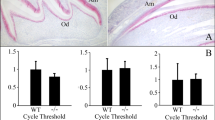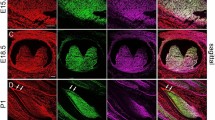Abstract
PREVIOUS studies in amelogenesis have shown that the organic matrix of enamel undergoes marked changes during development. These include a loss of protein and a change in the amino-acid composition1–3. Experiments with labelled protein precursors show that label first appears in a discrete layer in the enamel but soon spreads throughout the matrix4,5. Only tentative explanations for such processes have so far been put forward2,3. More recently, however, preliminary histochemical studies have shown that several enzymes belonging to the lysosomal system are present in ameloblasts6. Lysosomes are known to participate in both intra and extracellular degradative processes7, and it is possible that lysosomal enzymes may be the agents responsible for some of the changes observed in enamel matrix during development. We have investigated this possibility using the more powerful technique of enzyme cytochemistry combined with electron microscopy.
This is a preview of subscription content, access via your institution
Access options
Subscribe to this journal
Receive 51 print issues and online access
$199.00 per year
only $3.90 per issue
Buy this article
- Purchase on Springer Link
- Instant access to full article PDF
Prices may be subject to local taxes which are calculated during checkout
Similar content being viewed by others
References
Glimcher, M. J., Levine, P. T., and Bonar, L. C., J. Ultrastruct. Res., 13, 281 (1965).
Eastoe, J. E., Brit. Dent. J., 121, 451 (1966).
Stack, M. V., Odont. Rev., 17, 101 (1967).
Young, R. W., and Greulich, R. C., Arch. Oral Biol., 8, 509 (1963).
Greulich, R. C., and Slavkin, H. C., in The Use of Radioautography in Investigating Protein Synthesis (edit. by C. P. Leblond and K. B. Warren), 199 (Academic Press, New York, 1965).
Katchburian, E., Katchburian, A. V., and Pearse, A. G. E., J. Anat., 101, 783 (1967).
De Duve, C., and Wattiaux, R., Ann. Rev. Physiol., 28, 435 (1966).
Karnovsky, M. J., J. Cell Biol., 27, 137A (1965).
Novikoff, A. B., Albala, A., and Biempica, L., J. Histochem. Cytochem., 16, 299 (1968).
Reith, E. J., J. Ultrastruct. Res., 17, 503 (1967).
Katchburian, E., thesis, University of London (1968).
Warshawsky, H., Anat. Rec., 161, 211 (1968).
Garant, P. R., and Nalbandian, J., J. Ultrastruct. Res., 23, 427 (1968).
Dingle, J. T., Fell, H. B., and Glauert, A. M., J. Cell Sci., 4, 139 (1969).
Vaes, G., Bruxelles Médical, 46, 1133 (1966).
Smith, R. E., and Farquhar, M. G., J. Cell Biol., 31, 319 (1966).
De Duve, C., in Injury, Inflammation and Immunity, 283 (Williams and Wilkins, 1964).
Author information
Authors and Affiliations
Rights and permissions
About this article
Cite this article
KATCHBURIAN, E., HOLT, S. Role of Lysosomes in Amelogenesis. Nature 223, 1367–1368 (1969). https://doi.org/10.1038/2231367a0
Received:
Issue Date:
DOI: https://doi.org/10.1038/2231367a0
This article is cited by
-
MiR-153 Regulates Amelogenesis by Targeting Endocytotic and Endosomal/lysosomal Pathways–Novel Insight into the Origins of Enamel Pathologies
Scientific Reports (2017)
-
Electron microscopic localization of 5?-nucleotidase in the stratum intermedium and ameloblasts
The Histochemical Journal (1978)
-
Acid phosphatase in the Golgi apparatus of cells forming extracellular matrix of hard tissues
Histochemie (1973)
-
The decrease in the concentration of organic material in the course of formation of the enamel matrix
Experientia (1972)
-
New methods for the demonstration of lysosomal hydrolases by the formation of osmium blacks
Histochemie (1972)
Comments
By submitting a comment you agree to abide by our Terms and Community Guidelines. If you find something abusive or that does not comply with our terms or guidelines please flag it as inappropriate.



